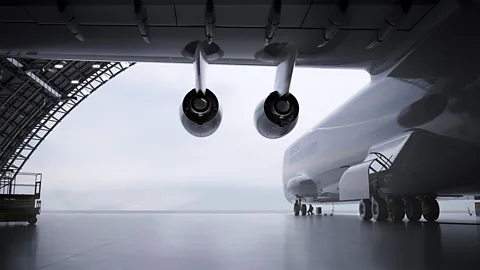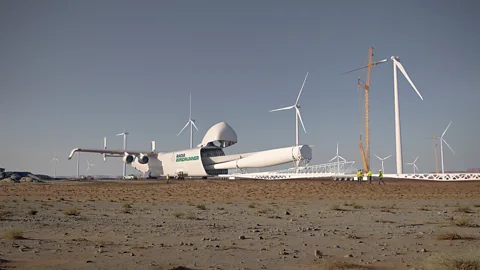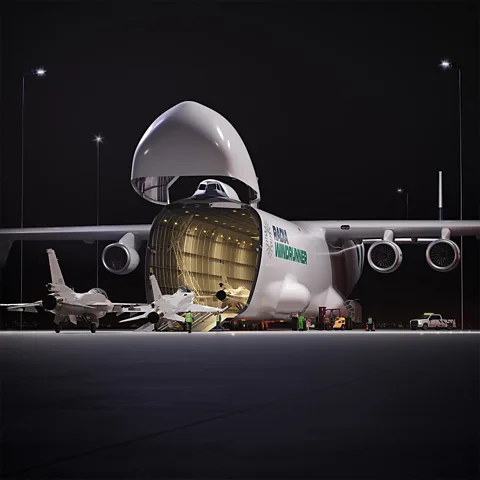The upstart company that wants to build the world's largest aircraft
 Radia
RadiaThe WindRunner is an ambitious aircraft project that could make it easier to use larger wind turbines. The company behind it, however, has never built a plane before.
The WindRunner is already being called the largest aircraft in the world, before it has even been built. But this leviathan is not being made by Airbus, Boeing or Lockheed. It is being made by a company that has never built an aircraft before.
Serial entrepreneur and aerospace engineer Mark Lundstrom founded Radia in 2016 to massively expand the size of the onshore wind power industry after he had a "eureka moment". Wind turbine blades installed offshore can reach 100m (345ft) in length – or more – much larger than those on land which tend to be only around 70m (230ft). This is due the difficulty of transporting something so large from the factory to a remote site on a plain or plateau. This in turn limits the economic viability of onshore wind power.
If this problem could be solved, Lundstrom thought, then the longer blades would help onshore wind farms to produce more energy at a lower cost. "They can double or triple the economically viable land in the US for wind farms," says Lundstrom, and could enable the building of over one million of these "super" turbines by 2050, globally. The entrepreneur calls his vision "GigaWind".
Now the company based in Boulder, Colorado has raised more than $150m (£110m) and attracted high-profile advisers to launch a possible solution: the WindRunner. The largest heavier-than-air machine in history is designed to make the transport of huge wind turbine blades a great deal easier and, Radia claims, trigger a revolution in onshore wind power.
"We are building the world's largest aircraft and we're doing that because there's a gigantic gap in the capability of heavy-lift aircraft," says Lundstrom, the company's CEO and founder. "It amazes me that there is no large cargo aircraft in production or planned to meet this need, except for the Radia WindRunner.
 Radia
Radia"It's the inability to move big things that is basically the barrier that prevents us from super-sizing onshore wind turbines," he says.
There is one additional challenge. This huge machine must be able to navigate the runways and taxiways of existing airports as well as operate on the types of relatively short, semi-prepared airstrips that can easily be built next to wind farms.
Such outsized giants have a precedent. The huge six-engine Antonov An-225 Mriya ("Dream" in Ukrainian) cargo plane used to be the world's biggest aircraft. Its cargo hold was longer than the Wright Brothers' first flight, from take-off to landing. But it was the only one its kind ever completed. Its destruction during the first stages of the Russian invasion of Ukraine in 2022 was a symbolic blow to Ukraine, and a literal one to the world's aviation community. Overnight, the ability to transport extremely large and oversized cargo – whether complete railway engines, wind turbine blades or disaster relief – was lost.
What's more, the An-225's one-time rivals in the strategic airlift category, such as the Boeing C-17 Globemaster, the Lockheed C-5 Galaxy and the Antonov An-124 "Ruslan" are all out of production, growing long in the tooth and – particularly in the case of the Antonov – less available owing to the war in Ukraine.
There was only one problem when Radia considered this new project: it had never built an aircraft before. Lundstrom assembled an experienced team to design its specification before it was unveiled at the Farnborough International Airshow in 2024. An airship was one solution the team considered, but they decided on a huge fixed-wing aircraft. "We looked at all the different possible ways to move big components," says Lundstrom, "and decided that the best way to go is to a fixed-wing aircraft, designed around aerospace components most of which are in already in mass production today."
The most distinctive feature of this gargantuan fixed-wing aircraft is its huge straight wing, needed to take off and land on a relatively short semi-prepared runway.
If it is constructed, the massive cargo lifter will measure 108m (356ft) in length with an 80m (261ft) wingspan, dictated by the need to load its cargo at a modern airport, and would have a vast payload bay around six times bigger than that of the Antonov An-225.
 Getty Images
Getty ImagesIt would have the biggest cross-section of all heavy-lift aircraft yet constructed. It would be able to haul three 80m (260ft) wind turbine blades, or two 95m (310ft) ones, or one 105m (345ft) blade, and land on a 1,800m (6,000ft) unpaved runway. But it will only be able to lift 72,500kg (74 tonnes) and fly it 2,000 km (1,200 miles). This means the WindRunner, if it is built, looks likely to be confined to flights within North America, Europe or South America.
"Yes, there's lots of challenges," Lundstrom says. "But the fundamental principles of the WindRunner's development have been: don't do anything new, and develop the minimum viable aircraft that's necessary for the mission."
This means no new regulations, supply chains or hangars around the world. "This sadly rules out airships."
To make this vision a reality, Lundstrom and his team have recruited experienced suppliers , including Italy's Leonardo for the fuselage, Spain's Aernnova for the wing and engine pylons, and the United States's AFuzion to oversee safety features.
However, the lack of a named engine supplier has raised questions about the project's viability. But a Radia spokesperson told the BBC that this should not be an issue for much longer. "We have selected an existing certified engine and have been doing work to define the integration strategy on the airframe. We will be announcing the engine partner in the future.
"We expect the development will be cost-effective thanks to Radia's emphasis on reusing as many existing systems, components and technologies as possible," they added. "The unit cost will be commensurate with the weight and size of the aircraft, and therefore comparable with other wide-body civil aircraft."
The aerospace industry has had visionaries in the past who similarly wanted to build the heaviest plane ever made, or the largest aircraft ever to fly. Like them, they have, at most, only built one or two examples of these outsized machines.
 Radia
RadiaNaturally, some observers are cautious about the prospects of the WindRunner. "I just don't see how it is going to work unless they can get more capital investment," says aviation author and commentator Chris Pocock. "The WindRunner doesn't have transatlantic range and so it is not as attractive from that point of view as an outsized cargo carrier."
Pocock also believes Radia was "too dismissive" of airships as a solution. "The designers of hybrid airships are eyeing the same market," he says. "The two most credible hybrid airship designs are not currently designed to carry cargo this size, but they both could be scaled up."
It may be that politics simply gets in the way. US President Donald Trump has called wind power "garbage" and has issued an executive order against its expansion. But the advantages of onshore wind energy, plus the need for energy security, may help make a business case for it in the US.
In May 2025, the US Department of Defense signed an agreement with Radia to study how the WindRunner could carry military cargo. This appeared to be a pivot away from the wind turbine market. But a Radia spokesperson told the BBC that this is not the case. "Radia's core mission remains serving the onshore wind energy market… but WindRunner's unique capabilities mean there are many additional applications, including defence."
In an email to the BBC, Radia said their last funding round was oversubscribed, and they are now working with governments and investors on the next major and larger infusion of investment.
 Radia
RadiaSo far, however, Radia have only tested a very small-sized WindRunner model in a wind tunnel. Like other aviation manufacturers and startups, Radia appears to be keen to speed up, and reduce the cost, of the lengthy expensive process to certify the WindRunner safe to fly. To do this along with the use of certified components, they don't plan on building a traditional prototype. Rather, the use of digital design tools should enable the company's next step to be the building of several full-sized test aircraft, the first flight of which is planned by the end of the decade, and then go straight into production. But certification is a daunting process for any aircraft manufacturer, let alone a new one.
More like this:
• Pathfinder 1: The airship that may under in a new era
• Can we really fuel planes with fat and sugar?
• Balloons built for the edge of space
"I… spent a lot of time working with a startup at a former employer," says aviation analyst and commentator Bill Sweetman. "There was a hard business case, a lower technology risk [than the WindRunner], far smaller in scale and easier to get into production, but it was still hard to certify."
The news that Boeing is in the very early stages of discussing the possibility of restarting production of its rival C-17 only adds to the pressure WindRunner faces, even if, as a Radia spokesperson in an email tells the BBC, there is enough pent up demand for both planes, and the WindRunner should be flying before any new C-17 rolls off the production line.
Is the prize WindRunner hopes to claim moving out of reach before the race starts?
--
If you liked this story, sign up for The Essential List newsletter – a handpicked selection of features, videos and can't-miss news, delivered to your inbox twice a week.
For more science, technology, environment and health stories from the BBC, follow us on Facebook and Instagram.
